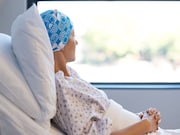Additive risk seen between combined anthracyclines and radiotherapy doses to the breast
TUESDAY, Oct. 29, 2019 (HealthDay News) — The combination of anthracyclines and radiotherapy doses to treat childhood cancer is associated with an increased risk for subsequent breast cancer, according to a study published online Oct. 28 in JAMA Pediatrics.
Lene H. Veiga, Ph.D., from the U.S. National Cancer Institute in Bethesda, Maryland, and colleagues evaluated breast cancer risk in childhood cancer survivors following radiotherapy and chemotherapy. Using data from five-year survivors of childhood cancer (diagnosed from 1970 to 1986 and followed up through 2016), the researchers identified 271 women with subsequent breast cancer and 1,044 controls matched to cases (4:1) by age at first cancer and duration of follow-up.
The researchers found that of the women with subsequent breast cancer, the median age of their first cancer diagnosis was 15 years, while the median age for the breast cancer diagnosis was 39 years. There were 201 invasive cases (113 estrogen receptor positive [ER+], 41 ER−, and 47 unknown) and 70 in situ breast cancers. Increasing radiation dose increased the odds of breast cancer (odds ratio [OR] per 10 Gy, 3.9; 95 percent confidence interval [CI], 2.5 to 6.5) and was similar for ER+ and ER− cancers (ORs, 5.5 [95 percent CI, 2.8 to 12.6] and 4.8 [95 percent CI, 1.7 to 22.3], respectively). Compared with women who received ovarian doses ≥15 Gy (OR, 1.4; 95 percent CI, 1.0 to 6.4), for women who received ovarian doses <1 Gy, the OR per 10 Gy to the breast was higher (OR, 6.8; 95 percent CI, 3.9 to 12.5). With cumulative anthracycline dose, the OR for breast cancer increased (OR per 100 mg/m², 1.23; 95 percent CI, 1.09 to 1.39; P < 0.01 for trend) and was higher for ER+ cancer (OR, 1.49; 95 percent CI, 1.21 to 1.83) versus ER− cancer (OR, 1.10; 95 percent CI, 0.84 to 1.45; P value = 0.47). For the combined association between anthracycline therapy and breast radiation dose of ≥10 Gy (compared with 0 to <1 Gy), the OR of breast cancer was 19.1 (95 percent CI, 7.6 to 48.0) versus 9.6 (95 percent CI, 4.4 to 20.7) without anthracycline use (P = 0.04).
“These results might help inform surveillance guidelines for childhood cancer survivors,” the authors write.
Copyright © 2019 HealthDay. All rights reserved.








